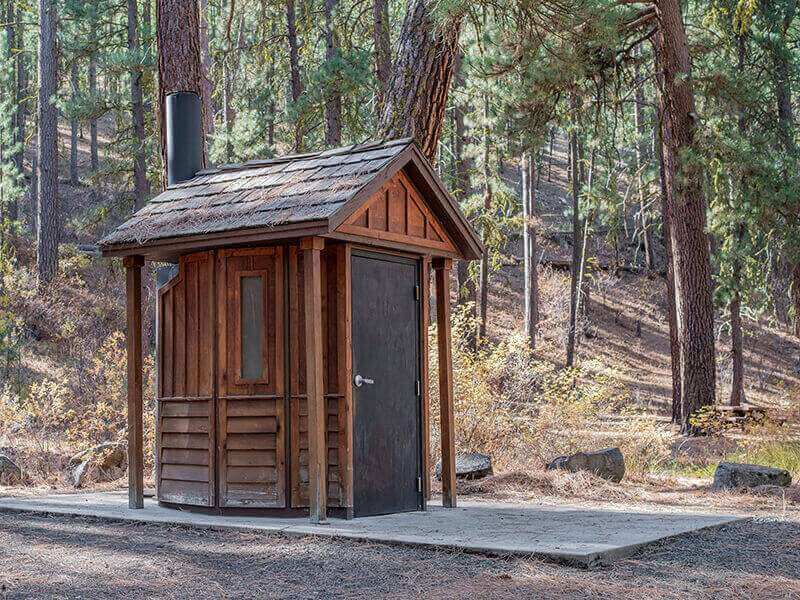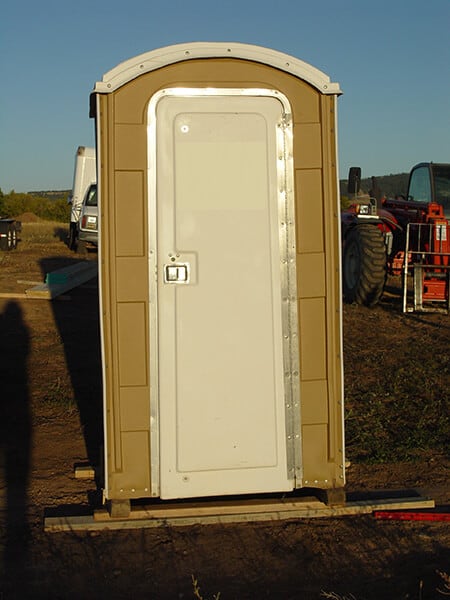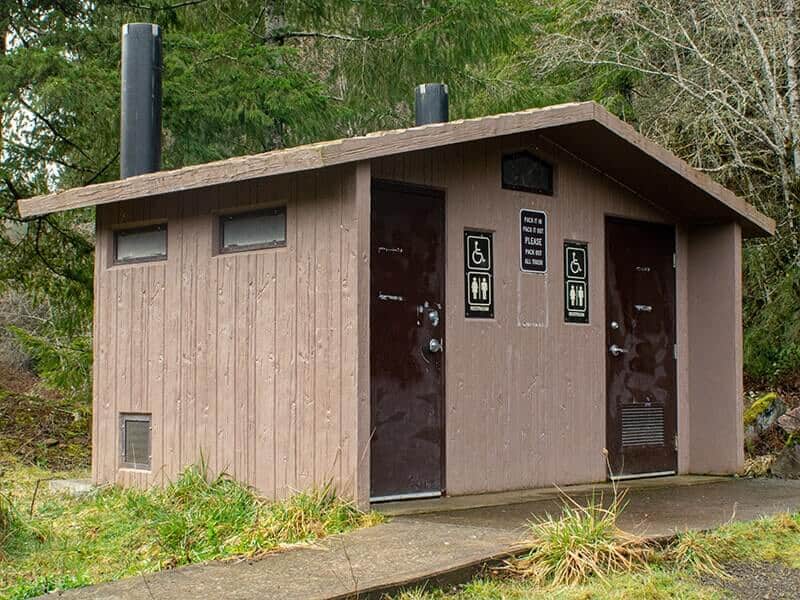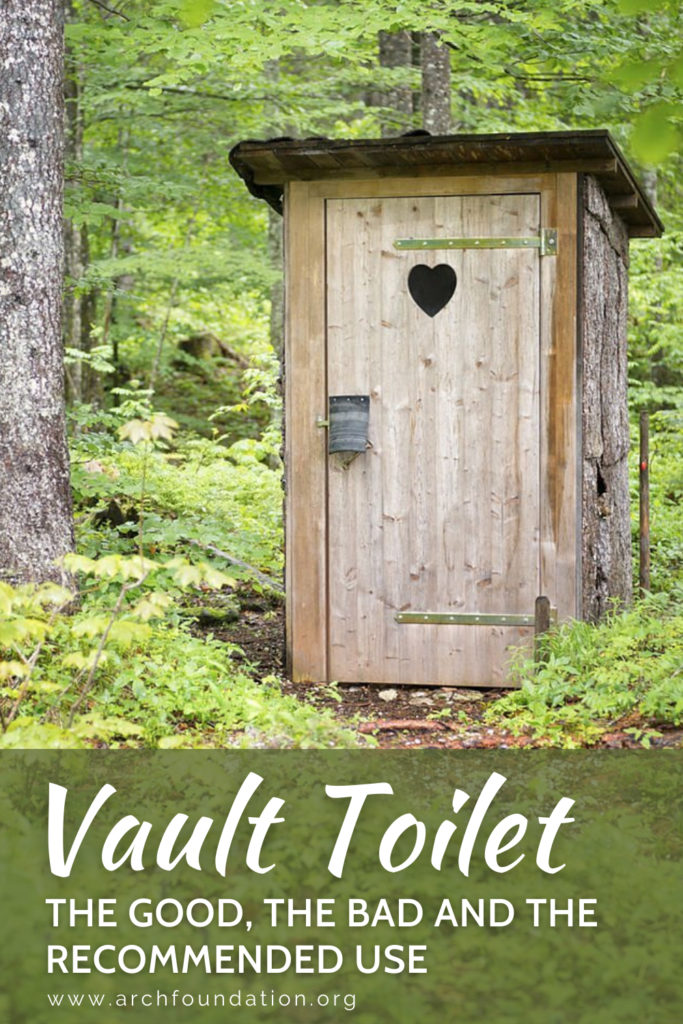Vault Toilet – The Good
If you have ever been to campsites, you have probably seen vault toilets. But have you ever thought about the mechanism behind vault toilet use, waterless technology, odor control, and every other important aspect? Do you need a vault toilet? Keep reading to find out!
The idea of a waterless toilet probably sounds gross to you. However, the engineers that designed vault toilets back in the days did work well. Vault toilets have their purpose. It is to replace the standard toilets when there is no water line around.
They do provide a certain level of comfort and help you take care of the environment.
A vault restroom, which is the synonym for vault toilet, isn’t the only type of waterless toilet you can come across. The composting toilets, pit toilets, and outhouses don’t need water to fulfill their purpose.
If you love to have a getaway in nature, maybe a vault toilet can be a sanitary solution for your distant property. For many people, vault toilets are acceptable in public spots, but would it solve your problems? Keep reading to find out!

Vault Toilet at a Glance
A vault toilet consists of a hole in the ground that holds a waste tank. The tanks need to be regularly emptied, so the toilet stays operative. Vault toilets are suitable for use on public sites and can last indefinitely. They operate as individual objects without plumbing, water flushes, and sewer line connections.
What is a Vault Toilet?
A vault toilet doesn’t have a flush option. Instead, the toilet bowl is on an underground tank that holds human waste. But, vault toilets are serviced by the U.S. Department of Agriculture (USDA) or by private waste management companies.
These toilets are used in areas where there is no running water or sewer lines.
Most commonly, vault toilets are made from concrete and have powerful vents that hold to prevent unpleasant odors from occurring. The vents also play a role during routine maintenance and waste discharge.
The majority of vault toilets have a 750 to 1.000 gallons waste capacity. Some models used on large construction sites with thousands of construction workers have an extended capacity of 13.000 gallons.
Also, vault toilets aren’t only for individual use. Many campers use them to empty their camping toilets.
How Does a Vault Toilet Work?
The principle behind the vault toilet is simple. The vault holds the human waste temporarily until the servicing company empties it. Vault toilets give privacy and some comfort to the users and are relatively easy to keep clean.
Human waste isn’t the only thing that goes into the vault toilet. You can empty other organic waste that decomposes, but you should never use a vault toilet to discharge trash that doesn’t decompose in water. It can cause a vault toilet to clog, and the unpleasant odors can get unbearable.
The primary vault toilet parts are:
- Fiberglass rises
- Toilet seat with a lid
- Vents
- Hard case
There is a hole in the floor with a riser on top and a toilet seat. The lid is an important part of the vault toilet, as keeping the lid down prevents unpleasant odors.
Watch this video to know more:
Vault Toilet Models
Even though all vault toilets are practically the same – waterless toilets, there are certain differences in available models. Let’s take a closer look at the vault toilets you can come across in different locations.
Single Vault System
A single vault system is just what the name suggests – a one-user toilet. It is the first designed vault toilet that has been in use for around 50 years. Both types of human waste go to the single vault alongside other organic, decomposing waste.
Double Vault System
The double vault has two single-occupant restrooms, each holding a single toilet. It has double the capacity of a single vault because it can handle two people at a time.
In some parts of the world, there are variations to these vault toilets. There are dehydration double vault toilets with urine diversion.
These toilets come from Vietnamese toilets and can be found in some rural places of Mexico, El Salvador, etc. They are sometimes built inside the house, and users use sawdust or ash to increase the waste dehydration rate.
The modern double-vault system utilizes the power of solar energy to increase the temperature inside the toilet chamber and increase the dehydration rate.
Unisex Vault
The third model you can come across has a similar capacity as a double vault, but it has a urinal and toilet. They are practical at busy campsites and near roads.
What Materials are Used for Vault Toilets?
As I already mentioned, the most common vaults are made from plastic, more specifically cross-linked polyethylene. It is semi-durable and easy to clean. The vault toilets can also have wooden chambers, but people used them more in the past.
Nowadays, vaults made from reinforced concrete are considered most durable, but also the most expensive. They are also more challenging to clean than plastic vaults because concrete isn’t as smooth as plastic.

Vault Toilets and Other Non-Standard Options
People who aren’t used to vault toilets often mix them with pits and other non-flush and flush, non-standard toilets. What are the differences? Check the following section.
Vault Toilet VS Outhouse
A vault toilet is actually very similar to an outhouse. But, the outhouse is more of a term used to describe the structure that provides privacy for the user.
The outhouse is an individual structure, separate from a house or other building. It can have a pit latrine, bucket toilet, composting toilet, dehydration toilet, vault, etc.
In simple words, the outhouse is a structure and not a separate type of non-flush toilet.
Vault Toilet VS Porta Potti
A vault toilet is a waterless, non-flush toilet, while a porta potty has a flush. It is the primary difference, but it doesn’t necessarily mean one is better than the other.
Porta Potti has a flush mechanism like the standard toilet and a tank for holding waste. But, the tank is significantly smaller than the tank in vault toilets. Therefore, porta-potties are designed for personal use, while vault toilets are created to accommodate a large group of people in a longer time period.
Porta potties are less likely to develop unpleasant odors than vault toilets. But, they are inconvenient because you have to empty them often. Additionally, because the tank holds the human waste and the water used for a flush at the same time, the tank capacity is significantly reduced.
You have to empty porta potties at least one time per week, and it only applies to a single user. If more people are using the same porta Potti, you have to empty it every other day.
Here is another difference. Porta-potties are maintained by owners and companies service vault toilets. You have to clean porta potties and manually empty them, which can be very unpleasant.
Vault Toilet VS Pit
First of all, a vault toilet is used in public spaces, while the pit is a personal solution for a toilet where you don’t have access to water or sewer lines. The construction of a pit and vault toilet is similar. The vault toilet has a cover and a hole in the ground that holds the water-impenetrable tank. If the hole is without the tank, it is a pit.
A pit toilet can be easily built, in a DIY construction. You can start by digging a hole and covering it with a wooden bench, then making a structure that ensures privacy. A pit toilet doesn’t have to be emptied or maintained apart from cleaning.
A vault toilet is maintained by regular emptying and cleaning by specialized companies.
In simple words, waste stays in the pit hole until it decomposes on its own. Therefore, unpleasant odors are more likely to happen. But, you can use sawdust after every use for odor control. Some people even built a vent pipe to help the odors disappear.
Once the hole is full, a pit toilet isn’t usable anymore.
On the other hand, a vault toilet may last forever with the frequent emptying and pumping of the waste. The odor issues are similar.
Because a vault toilet can be used forever, you’ll never have to relocate it.
Ultimately, vault toilets are a permanent waste option in distant and rural areas, camping sites, and construction sites. But, they couldn’t be used in areas where there aren’t any roads, to transport the waste. In those areas, pits are the only sanitary solutions.
Watch this video to know more:
Vault Toilet Advantages and Disadvantages
Do you understand what vault toilets are by now? Let’s sum everything up with a simple overview of the most important vault toilet pros and cons!
Advantages of Vault Toilets
Vault toilets have a sealed container in the ground and a shelter on top of it. The primary advantages of these toilets are:
- Privacy
Vault toilets much-needed privacy on busy construction sites, campgrounds, festivals, etc.
- Portability
The plastic vault toilets are lighter and easier to transport from one location to the other. Therefore, they can be reused in places when there are no water or sewer lines installed. Once the location gets access, a vault toilet can be transported and reused.
- Durability
Vault toilets are reusable and can be used as a permanent solution for human waste.
- Odor Control
Vault toilets can get smelly. But with the proper use of chemicals, most people find them comfortable, or at least tolerable.
Disadvantages
Vault toilets are used for decades, but the primary cons haven’t yet been overcome.
- Regular Maintenance
A vault toilet is only operable as long as there is someone who takes care of routine emptying and sanitization. If the tank gets full, the toilet isn’t usable.
- Faulty Ventilation
If the vault toilet hasn’t been designed properly, the faulty ventilation can cause disgusting odors.
Frequently Asked Questions
If you still have any misconceptions or doubts about vault toilets, please check the next section. Hopefully, you’ll find your questions answered! If that isn’t the case, please ask your questions in the comments!

Watch this video to know more:
A Vault Toilet Only for Public Spaces
If you are looking for a semi-permanent solution for a toilet in your distant cottage, a vault toilet is rarely an option. For you to install a vault toilet, you’ll need to invest a lot of money for construction and routine maintenance, and an infrastructure that can deal with waste management.
On the other hand, a pit toilet will work better for personal needs. Vault toilets are better suited for public places, such as campsites, festivals, construction sites, and on-the-road locations.
Have you ever used a vault toilet? If you learned something new in the article, please consider giving it a thumbs up!

